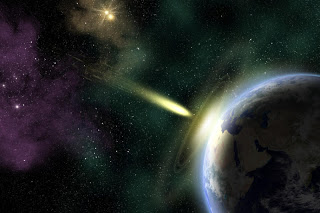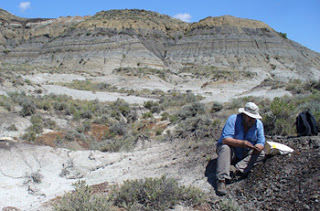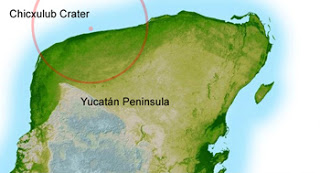
Feb. 7, 2013 — The demise of the dinosaurs is the world’s ultimate whodunit. Was it a comet or asteroid impact? Volcanic eruptions? Climate change?In an attempt to resolve the issue, scientists at the Berkeley Geochronology Center (BGC), the University of California, Berkeley, and universities in the Netherlands and the United Kingdom have now determined the most precise dates yet for the dinosaur extinction 66 million years ago and for the well-known impact that occurred around the same time.

The dates are so close, the researchers say, that they now believe the comet or asteroid, if not wholly responsible for the global extinction, at least dealt the dinosaurs their death blow.
“The impact was clearly the final straw that pushed Earth past the tipping point,” said Paul Renne, BGC director and UC Berkeley professor in residence of earth and planetary science. “We have shown that these events are synchronous to within a gnat’s eyebrow, and therefore the impact clearly played a major role in extinctions, but it probably wasn’t just the impact.”
The revised dates clear up lingering confusion over whether the impact actually occurred before or after the extinction, which was characterized by the almost overnight disappearance from the fossil record of land-based dinosaurs and many ocean creatures. The new date for the impact — 66,038,000 years ago — is the same within error limits as the date of the extinction, said Renne, making the events simultaneous.
He and his colleagues will report their findings in the Feb. 8 issue of the journal Science.
The crater of doom
The extinction of the dinosaurs was first linked to a comet or asteroid impact in 1980 by the late UC Berkeley Nobel Laureate Luis Alvarez and his son, Walter, who is a UC Berkeley professor emeritus of earth and planetary science. A 110-mile-wide crater in the Caribbean off the Yucatan coast of Mexico is thought to be the result of that impact. Called Chicxulub (cheek’-she-loob), the crater is thought to have been excavated by an object six miles across that threw into the atmosphere debris still be found around the globe as glassy spheres or tektites, shocked quartz and a layer of iridium-enriched dust.
Renne’s quest for a more accurate dating of the extinction began three years ago when he noticed that the existing date conflicted with other estimates of the timing of the extinction and that the existing dates for the impact and the extinction did not line up within error margins.
Renne and his BGC colleagues first went to work recalibrating and improving the existing dating method,

known as the argon-argon technique. They then collected volcanic ash from the Hell Creek area in Montana and analyzed them with the recalibrated argon-argon technique to determine the date of the extinction. The formation below the extinction horizon is the source of many dinosaur fossils and one of the best sites to study the change in fossils from before and after the extinction.
They also gathered previously dated tektites from Haiti and analyzed them using the same technique to determine how long ago the impact had occurred. The new extinction and impact dates are precise to within 11,000 years, the researchers said.
“When I got started in the field, the error bars on these events were plus or minus a million years,” said paleontologist William Clemens, a UC Berkeley professor emeritus of integrative biology who has led research in the Hell Creek area for more than 30 years, but was not directly involved in the study. “It’s an exciting time right now, a lot of which we can attribute to the work that Paul and his colleagues are doing in refining the precision of the time scale with which we work. This allows us to integrate what we see from the fossil record with data on climate change and changes in flora and fauna that we see around us today.”










